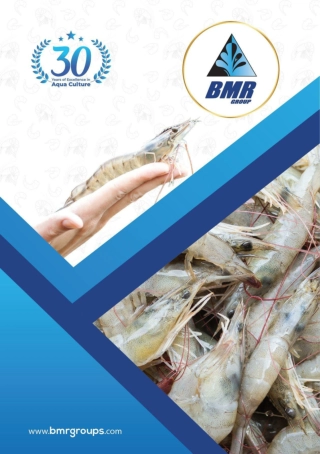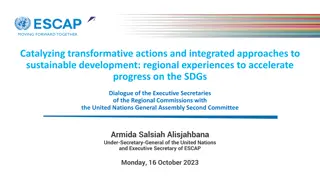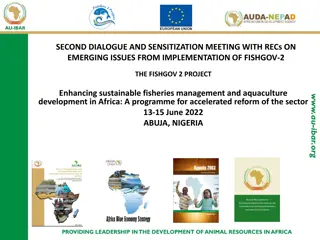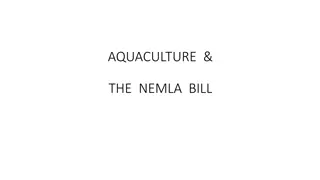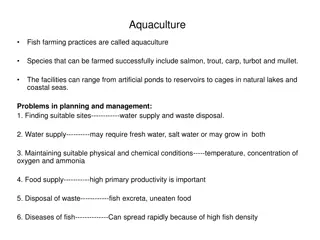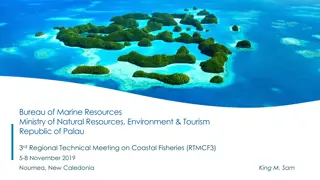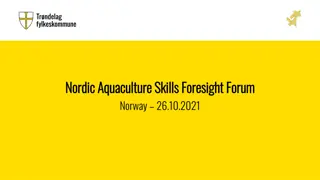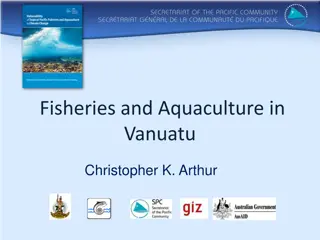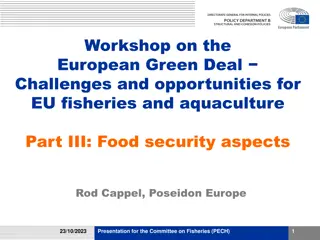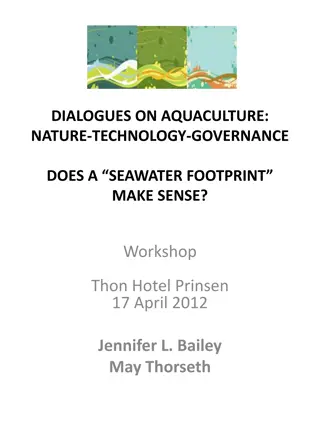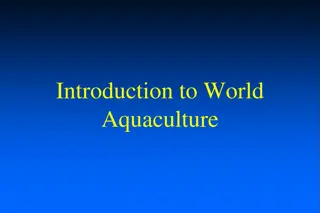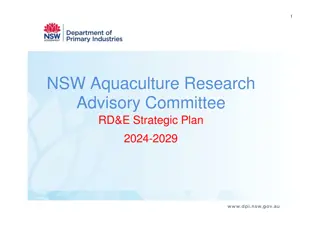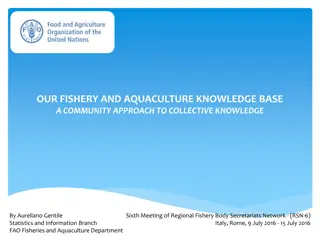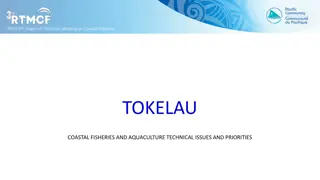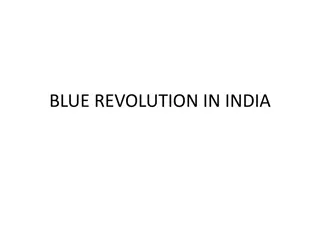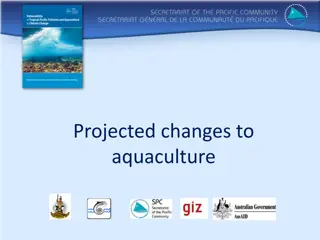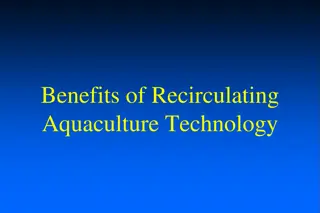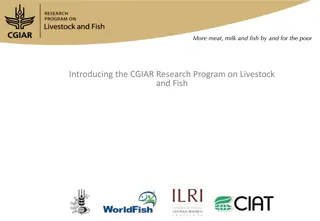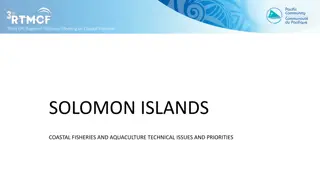Accelerating Livestock and Aquaculture Development for Sustainable Impact
Research-based approach to accelerate livestock and aquaculture development for the benefit of the poor by addressing the productivity gap, focusing on small-scale production, and leveraging partnerships with development actors to transform value chains and achieve sustainable impact.
Download Presentation

Please find below an Image/Link to download the presentation.
The content on the website is provided AS IS for your information and personal use only. It may not be sold, licensed, or shared on other websites without obtaining consent from the author. Download presentation by click this link. If you encounter any issues during the download, it is possible that the publisher has removed the file from their server.
E N D
Presentation Transcript
The Livestock & Fish Program Tom Randolph Nicaragua Dairy Value Chain Planning Meeting Managua, 5 August 2013
The challenge Can research accelerate livestock and aquaculture development to benefit the poor? Mixed record to date Systematic under-investment Also related to our research-for-development model? Focus on increasing productivity of small-scale production and marketing systems by the poor poverty reduction for the poor food security
Managing a smoother transition out of agriculture Estimates for smallholders in Africa and Latin America (Wiggins 2012; Dorward 2009) : 1/3 Will step up to become commercial farmers 1/3 Will step out and work for other, go to the city 1/3 Could go either way Can 2/3 be enabled to develop into commercial producers, accumulate capital and transition out of agriculture? deeper rural economic growth avoid social disruption (Johnston et al. 1995)
But productivity gap remains despite investment in livestock development Meat 6350 Milk (kg output/kg biomass/yr) (kg/cow/yr) 0.2 1980 1980 2005 0.17 4226 2005 0.11 0.08 0.06 0.06 1380 1021 0.04 904 0.03 411 517 397
Why havent we had more impact? Is it the piecemeal nature of our research? Solutions developed for isolated issues in specific settings, but ignoring other constraints in the value chain that discourage uptake Inputs & Services Production Processing Marketing Consumers ...in Country A Inputs & Services Production Processing Marketing Consumers ...in Country B Inputs & Services Production Processing Marketing Consumers ...in Country C Inputs & Services Production Processing Marketing Consumers ...in Country D
A smarter approach? Drawing from recent experiences, can we accelerate research to impact?
Approach: Solution-driven R4D to achieve impact #1: Addressing the whole value chain #2: Working directly to design and support intervention at scale #3: In partnership with development actors R4D integrated to transform selected value chains In targeted commodities and countries. Inputs & Services Production Processing Marketing Consumers Major intervention with development partners Value chain development team + research partners Strategic L&F CRP Cross-cutting Platforms Technology Generation Market Innovation Targeting & Impact INTERVENTIONS TO SCALE OUT REGIONALLY GLOBAL RESEARCH PUBLIC GOODS
#4 Focus, focus, focus! Working in 8 target value chains accountability SHEEP & GOATS AQUACULTURE PIGS DAIRY DUAL-PURPOSE CATTLE
Approach: Solution-driven R4D to achieve impact Our engagement in a value chain embodies our impact pathway Along the impact pathway PIPELINE Research partners Relative degree of involvement Knowledge partner Experiment s Evaluation Evidence Attracting investment Assessment Mobilization Best bets Implementin g large-scale interventions Design Piloting Lessons Context Advocacy Disseminatio n Development partners Year 1 8-12 Program horizon in a target value chain Year
Strategic partners RESEARCH DEVELOPMENT CARE SNV Novus SLU (Sw) Global Wageningen UR Global FAO NGOs (CRS,Heifer, ..) Private Sector Regional CATIE Regional UNA Local Local INTA TechnoServe Etc.
Our proposition Increased access to animal-source foods for the poor, especially women and children, can be achieved at scale by strengthening carefully selected meat, milk and fish value chains in which the poor can capture a significant share of the benefits. Technologies and lessons generated through this focused approach will be applicable in broader regional and global settings. More meat, milk and fish by and for the poor
Research outputs to global development goals MDGs - SDGs CGIAR System Level Outcomes 12-18 years Livestock & Fish goals Intermediate Development Outcomes + Target statements + Theory of Change 9-12 years Value Chain Impact Pathway VC1 Nicaragua VC2 Uganda VC3 India etc. behaviour direct benefit 3-yr milestones IPG Impact Pathway Enabling Environment 3-yr milestones 0-12 years CRP Activities + Outputs (research, capacity building, engagement)
Research outputs to global development goals MDGs - SDGs 12-18 yearsSLO1 Reduce Poverty SLO2 Food Security SLO3 Nutrition & Health CRP goals SLO4 Environment IDO1 Improved productivity IDO4 Reduce nutrient gap IDO6 Better policies IDO3 More employment & income, esp. for women 9-12 years IDO7 More forage? IDO2 More & better supply IDO5 Environmental benefits 0-12 years IPG Impact Pathway Value Chain Impact Pathway CRP Activities + Outputs Actionable options Engagement/transformation Process Evidence base
Status Partnership of 4 CGIAR Centers Officially started January 1st, 2012 Forming core team Developing strategy by component and value chain Identifying strategic partners Consolidating ongoing activities
Nicaragua Value Chain Progress so far VC Analysis (on-going) Bilateral projects being implemented Proposal Development Institutional linkages Key achievements in 2012 and 2013 Funding partly secured through bilateral projects (recent: ADA, FSP-Solidaridad Preliminary analysis value chain (workshops) Development of innovative concepts related to the dairy value chain, including carbon insetting and combining forage options with agroforestry practices
Nicaragua Value Chain Partners and other major actors Research institutes: CATIE Government: Ministry of Agriculture, INTA Famers associations cooperatives (CONAGAN, UNAG, NicaCentro) Sector organizations CANISLAC, CANICARNE Private sector Dairy and meat processing (Centrolac, Eskimo, MACESA, San Martin) Universities (national: UNA, UCA; international: Florida, Mississippi) Development organizations, NGOs, consultants CRS, Heifer, Solidaridad, TechnoServe
Nicaragua Value Chain Bilateral projects activities in 2014 THEME DONOR SINCE Integration of new forage hybrids to intensify agriculture and to mitigate climate change through regulation of nitrification in soil BMZ Mid 2012 Dry season forage options and dairy processing USDA through CRS Starting Increasing the productivity of dual-purpose cattle in Nicaragua through use of appropriate breed types and application of best husbandry practices ADA Starting Sustainable grassland intensification through ecosystem services and improved grazing management strategies USAID Starting Competitive beef and dairy through sustainable intensification and specialized market access Netherlands Government (FSP) / Solidaridad Starting
Nicaragua Value Chain Main activities expected in 2014 Refined VCA tools developed (2013) Situational analysis implemented using VCA tools Dual-purpose productivity improved in target areas Ecosystem services identified and validated (e.g., carbon insetting) to increase natural resource integrity and generate income Cattle farmers with acquired knowledge and implementing good farm management practices
Nicaragua Value Chain Main challenges we are facing Sustained funding (flagship) developing concept notes and proposals Critical mass hiring staff, collaboration/integration with other CRPs and partners (e.g., CATIE, Heifer) Knowledge/Expertise hiring specialized staff, collaboration with other CRPs, partners Partner involvement workshops, communicating results, advocacy Effective impact pathways workshops, consultations with partners/ vc actors
CGIAR Research Program on Livestock and Fish livestockfish.cgiar.org livestockfish.cgiar.org CGIAR is a global partnership that unites organizations engaged in research for a food secure future. The CGIAR Research Program on Livestock and Fish aims to increase the productivity of small-scale livestock and fish systems in sustainable ways, making meat, milk and fish more available and affordable across the developing world.


